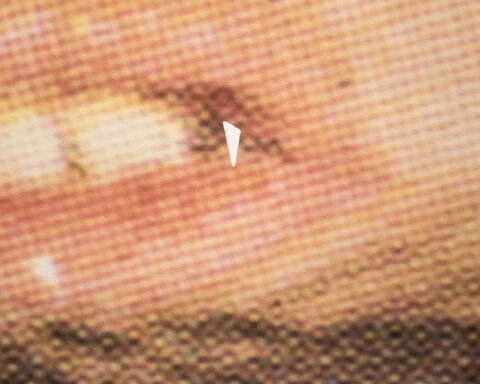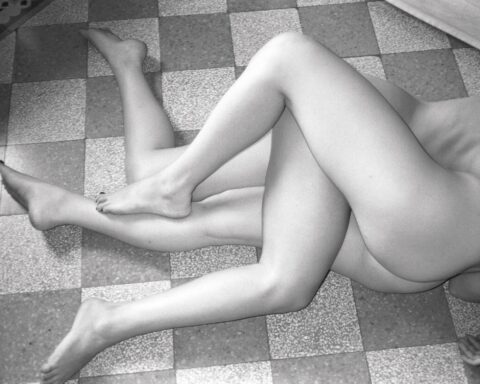With the show Estate, autunno the group formed at BoCs Art Cosenza, last July’s residency, presents itself in a new guise with a strong vitality of the connections developed in that time. This chapter set in Milan is the result of research born in Cosenza and developed through the following months.
The curators invited to take part are Irene Angenica, Giovanni Paolin and Giacomo Pigliapoco, they also involve the same artists of the residence for a new exhibition stage. Pietro Ballero, Jacopo Belloni, Paolo Bufalini, Giovanni Chiamenti, Davide La Montagna, Nicola Lorini, Matilde Sambo, Patrizia Emma Scialpi, Davide Sgambaro, Marta Spagnoli, Gabriel Stöckli and Alberto Venturini faced a collective work experience during the residency period in Cosenza, that concluded with the show A JUMI.
BoCs Art meant being part of a community, making an experience of inclusion, creating a shared process and a dialogue still ongoing among its participants. Aware of the fact that the process of creation of the works could not be formalized in just two weeks of residency, the whole group felt the need to work on a second exhibition appointment to discuss the evolution of different research without wanting to join them in a single conceptual and thematic strand.
BoCs Art is Cosenza’s artistic residency which is located within the architectural complex desired by the city council in 2015. The wooden study boxes that follow one after another along the bank of the Crati river are inhabited by different groups of artist every season. Since 2018 Giacinto Di Pietrantonio has been the curator of the annual program and this year during the summer slot He invited Irene Angenica (Catania,1991), Giovanni Paolin (Dolo, 1989) and Giacomo Pigliapoco (Senigallia, 1991) who were each asked to invite artists to share with the residency.
State Of is a new contemporary art space hosted by Aretè Showroom and located in Milan, inside the residential neighborhood of Porta Romana. Estate, autunno has been the inaugural exhibition of its program, now held by Manuela Nobile and Luca Zuccala, focused on creating a muldisciplinary platform exploring the numerous languages related to contemporary art practice.

Giacomo Pigliapoco: Well, here we are again after Estate, autunno in front of this table for the special celebration of exactly six months since our first meeting during the BoCS Art residence in Cosenza last July. For this special dinner all together, where it is objectively rare to be gathered together considering the respective cities where we live, we tried to also replicate the dishes and the alcohol to remember and remind us of old times.
Davide Sgambaro: I’m pretty sure that Estate, autunno is also the name of a pizza.
Irene Angenica: It will be a gluten-free pizza then! We should also think about the title to give to this article…Once again, find a title…What a pain.
Alberto Venturini: This group show was so nostalgic and the title reminds me of something close to Boys Boys Boys by Sabrina Salerno. I think the title of the article has to be something visceral and living, in my hometown we use “carnazza” to define something in between barbecue and porn.
Irene Angenica: Like Mrs. Anna’s kitchen?
Jacopo Belloni: Gosh no, like Francesca’s t-shirts! I would like to see them in our exhibition/showroom. I think Aretè may appreciate them.
Those t-shirts are evergreens. No cyclical seasons ️
Davide La Montagna: Just the thought of Anna’s pasta both for lunch and dinner still haunts me – I’m still sweating. My stomach has been literally destroyed – it was good though. Speaking of destruction, I wonder what happened to the destroyed blue sofa I used for the show in Cosenza…
Patrizia Emma Scialpi: I was wondering the same thing about the DIY stadium bench recovered for the exhibition with Jacopo.
Another title? Help! I don’t mind the suggestions Sabrina Salerno / Francesca’s t shirts anyway… Ah! Someone remember Anna’s husband’s t-shirt? Maybe we took a picture…
Davide La Montagna: It was something like “don’t bother me” but in a very “classy” way? What about a title like “Lost (in Cosenza) & Found (in Milano)”. too much?
Patrizia Emma Scialpi: Venturini, in my place “carnazza” is used to say “fuck” in a funny way…for the sausages I think.
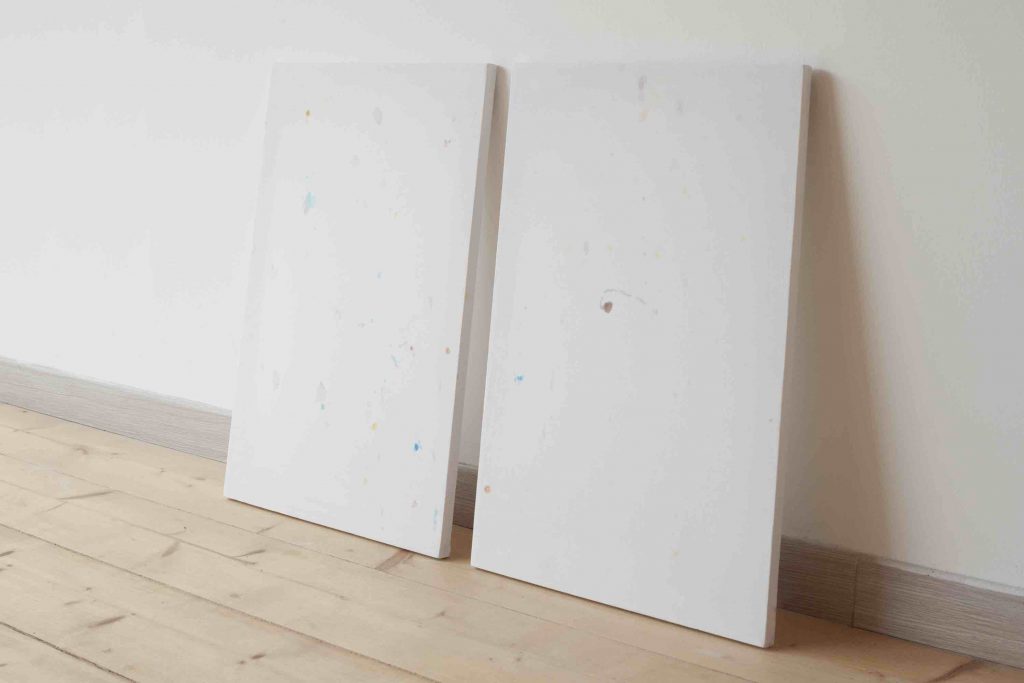
(906G1HAGP4OD) (921B1HAGP4OD). Installation view
BoCs Art Cosenza, 2019. Courtesy the artist and BoCs Art.
Photo Jacopo Belloni
Irene Angenica: I know what “carnazza” is from, the Skiantos’ song “Io ti amo da matti” (Sesso & Karnazza)…But let’s try to say something that makes sense also for the readers now. I guess I might ask you something like “how was your stay in Cosenza?” or “what expectations have you had about BoCs Art?” For most of you it was the first art experience in the deep south…
Davide Sgambaro: “How was your stay in Cosenza?” Hot and wet. “What expectations have you had about BoCs Art?” The nearest sea.
Perhaps we can use one of those answers as a title, it could include both proposals from Patty and Da.
Matilde Sambo: Well, talking about food, I started a new chapter of my life there! ‘Nduja’ and all the food of “Cantinetta” (was this the right name?) made an end point of my six years as a vegetarian. But well, I think that everything happens for a reason. There is always a cycle that at some point needs to be closed. I think it could be cool also asking ourselves: “What do I miss from those days?”
Dogs, staying up all night talking and watching (stripes) movie, sharing alcohol, hot days in the pool, hugs, gazes of complicity, crosswords, the sensation of freedom and relaxation when some of us went to the woods and to the lake. It was like starting to breath again after days inside the BoCs/box.
I didn’t have so many expectations, the whole last year was a little tough for me, so it has been a while since I try not to go to places and to people with expectations, but from the very first time, when I arrived there and started to meet all of you… well, I felt like home! No shame, just being myself, and being accepted no matter what. Everyone had their own rhythm and after a while we created a collective one, made by the crossing of energies, respect, sharing and free talking.
Something that I think we also brought and built during Estate, autunno in Milan.
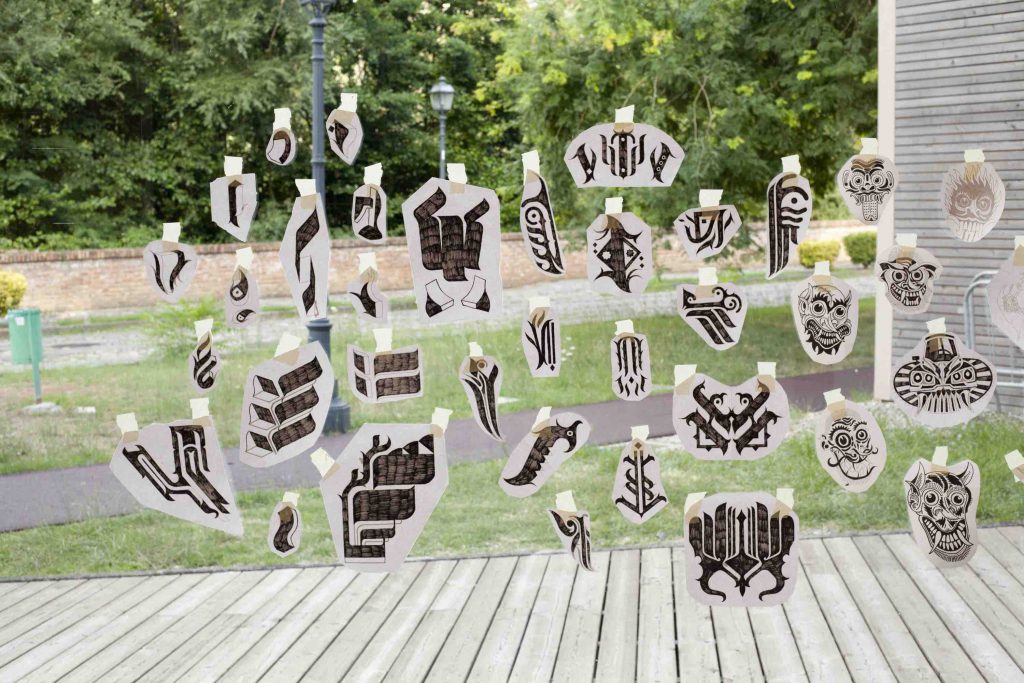
Alberto Venturini: The experience in Cosenza has worked up my curiosity with its different shades of ambiguity: by contrast, like seeing the Calatrava bridge and the beautiful old bohemian historical city center that collapses, or by similarities, like having an aquarium as a studio literally on the street, the same on which prostitutes worked until recently. Locals didn’t pay much attention to us and we were forced to live in a community of artists in which many of us had the same vibes and this allowed me to concentrate on my work and people I was living with, also because I was trying to tattoo most of them… I really loved the inflatable pool with waterfall we all bought together! Chiamenti in that pool, with his moustache, was like Magnum P.I. to me! This group was super cool! The only missing thing was an orgy, for this reason I insist with “carnazza” as a title!
Giovanni Chiamenti: If I think about our experience in Cosenza the first thing that comes to my mind is “TONICO CALDO” that should have been our title for the final exhibition, but became the one for our collective work, the beloved inflatable pool.
The title describes perfectly the sinergy we had as a tight-knit group and it describes our evenings together drinking hot gin & tonic from the same bottle. Also, even if we approach art in different ways, we respected each other and listened. I think we all took something back home from our companion’s thoughts during the evening presentations. I have been to different residencies but I’ve never found a group like this, with this kind of strange energy where everyone seems to be at home and has no filters from the first day of cohabitation.
Probably we were all so close because at the end we are a group of stray dogs wandering around… searching…
Jacopo Belloni: “Inflammable pool” could also be a nice title!! (I know, I’m really sick about searching titles). However, I think these moments where a group of artists and curators are all together sharing opinions and feedback are really rare after the academy period. It’s for that I was surprised to find this kind of generosity between people who, most of them never having met each other before. I think this mood of mockery between peers and, in the meantime, take care of them and their research was the most important aspect of this residency.
I can resume that our perceptions were switching continuously between sharp lucidity and blurry leisure (due to the warm gin and Anna’s kitchen)
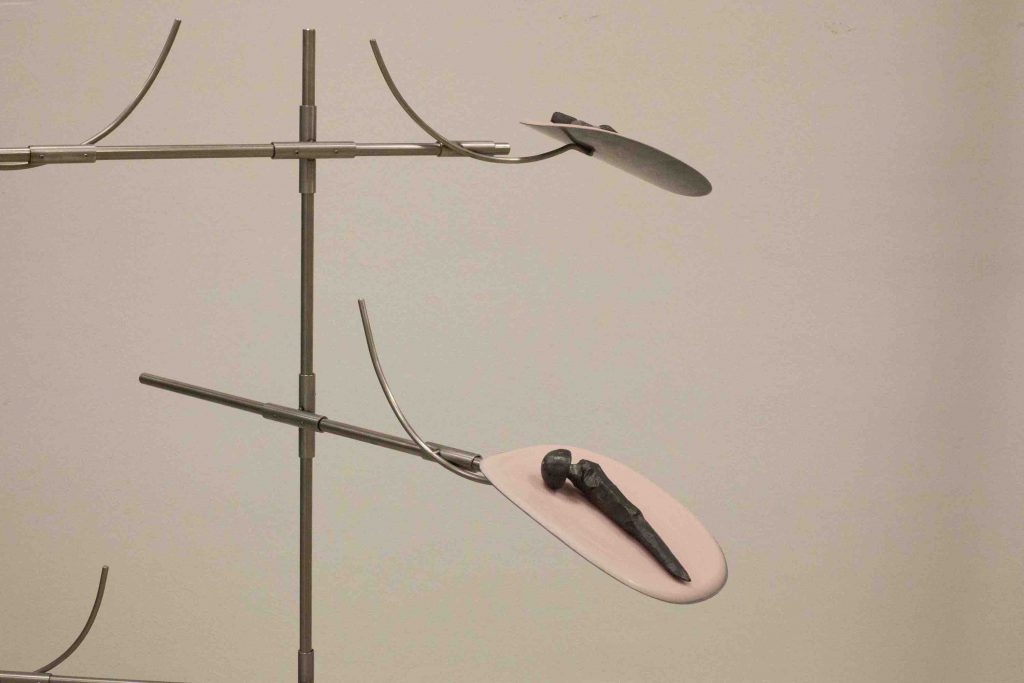
Giacomo Pigliapoco: And then suddenly, in a midsummer night, half toned and half hot as just said by Jacopo, our bodies were in unison conveyed into the solution regarding the title of our, at that time first and only, exhibition chapter. After an idiosyncrasy towards countless aspects, concepts, anecdotes and various cultural references, the epiphany on the title was complete. I remember freshly all details about the nights spent supposing the title: for example it’s vivid in my mind, a certain point of one night when Belloni and Chiamenti stood up saying: Tonico Caldo. Do you remember?
After laughing a lot we agreed about a dialectical expression typical of the city of Cosenza that referred to the river where the residency is located: the Busento river. A particular river, silent and dangerous at the same time, like people who have something to hide, often guilty of misdeeds and snares. Through our words we wanted to break that negative aura, so the title result was a small extract from this byword: A jumi cittu un ji a piscà. A JUMI.
Giovanni Giacomo Paolin: …and after GP can only come GGP! How are you fellows? I really think this is the right way to approach an article on this experience, in the end the entire residency was based on our words, whether they were wise, dumb or simply altered.
For me – and I think it comes out from the first part of this dialogue – the real moment that changed everything was the first meal all together, during that we could actually feel involved in something as a group. Unfortunately I don’t remember the instant in which we decided to work together for a group show, could someone help me? In my memory this was a very fluid and natural decision that no one opposed.
The only few problems during the residency came when something was forced or obliged. It’s clear from our experience that we have to talk about something more than the mere artistic encounter and focus on the atmosphere during those days.
Davide La Montagna: I don’t actually remember the exact moment where we chose to do a group show instead of a classical open studio – considering the fact that the open studio was the classical format as a residency restitution -, but I do remember talking with Irene after a lunch, walking towards Lungofiume 3 saying that there was an idea of organizing a group show. After that, everything turned out as a whirlpool where all of us started a huge and quick brainstorming, that ended up with the collective work Tonico Caldo (Real Estate).
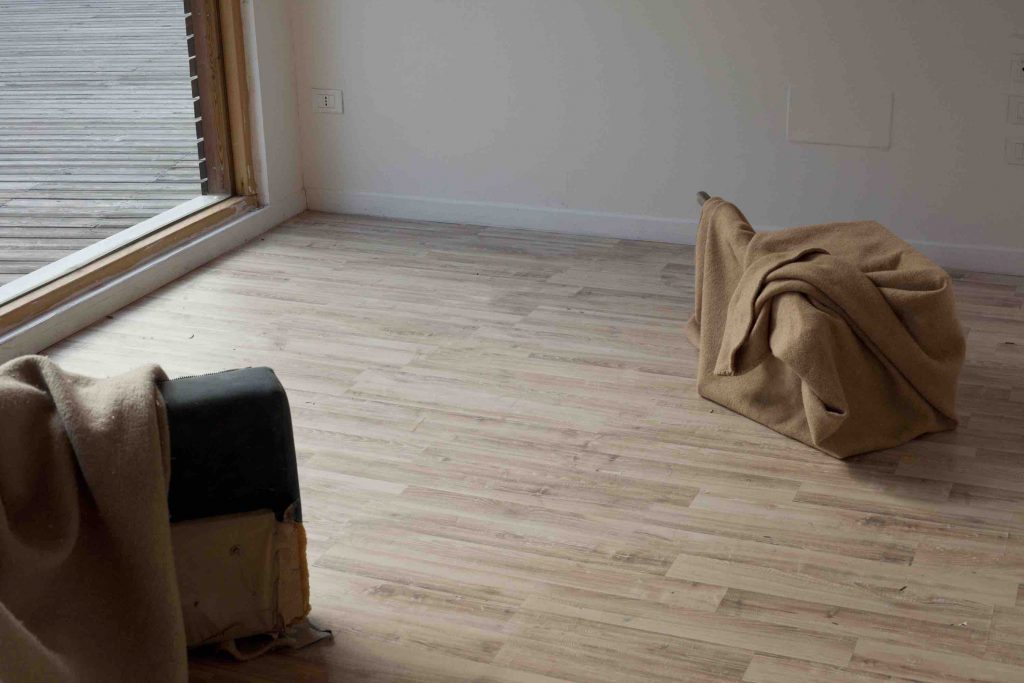
Davide Sgambaro: I believe that the idea of working in one place, and therefore with the form of a collective open studio where the works interacted with each other, had come out of a need for comparison. I remember that initially my group was in the farthest boxes and from there we felt the need to work more closely. I guess it’s the only way to face a short-lived residence and in fact I think it has paid off.
I also enjoyed having the three curators work together. This aspect has been masterfully managed and I think it came very naturally. It was certainly easier for us to devote ourselves to research and work. Furthermore, I was very critical of having an entire box each to be filled and used as a “showcase” after only ten days of residence where at least two were used for the trip, not to mention the lack of budget for production and coverage.
Irene Angenica: I remember that before arriving in Cosenza I was already assiduously talking by phone with Giacomo and Giovanni (poor them, sometimes I do admit I can be really annoying) to organize screenings or other activities to encourage dialogue between the various members of the group. I mean… for me working in a collective sense is something very spontaneous and natural, especially after this year of total sharing within a curatorial collective, however, it was also very stimulating to work with two curators with whom I had never collaborated before. We set up a very synergic and in-dialogue way of working, we actually are very complementary… in a certain way it was a very different experience of living the curatorial approach in a choral way compared to how I had lived (and am living it) with CampoBase. In the end we all worked a lot and it has been a very productive time for everyone, from which we learned a lot from each other. The only thing that I regret a little that we took few trips together, we should have all gone to the sea more often!
The artists have always been very focused on the production of their works. I guess it was very stimulating for them to be so free and to have so many people listening (even though the no budget situation was a big deal). I remember that super warm afternoon when after a huge lunch I did studio visits to all of them with Giovanni and Giacomo. It has been so fun and interesting to see the research of each of them with different curatorial perspectives, and find details and nuances that alone I would never have noticed. I’m thinking that at this point it could be very interesting that each of you can also tell a little about your research and how you worked on your production.
Pietro Ballero: If I have to write about my research and production in Cosenza I must make one premised. Due uomini e uno Sgambaro was the turning point of my BoCs experience; Ire, Gio and Giacomo proposed for us to present our research and our works in a sort of public program open to all and focused on knowing us better. My answer: ”Brilliant idea! But please, please, please don’t get me started”. Of course I was scheduled in the first “round”, together with Jacopo and Davide. Usually I get nervous quite easily, in this case I was panicked: it was my first time ever in a residency, I was surely the artist with less experience of all, I already knew and admired the works of many of them and I trembled at the thought of being unable to get accepted in this community… I survived the presentation and this agitation has become one of the subjects of my research during those days.

Gabriel Stoeckli: Hello beautiful people, sorry, now I’m here ehehe… I left for the residence with few ideas, but knowing that I wanted to take a summer break, meet new people and maybe start new works. Playing the Petanque is relaxing, communal; a good start for reflections. Eat well, drink, walk, adjust the air conditioning in the room, compare yourself with others… it was a beautiful experience.
In Milan I presented a new work born from those times, but with other values; a play set for collectors? ![]()
Davide La Montagna: Well, if I have to be completely honest, I wasn’t concerned at all about the production. I do have endless notes written in my telephone and on various notebooks with projects and works that I will produce for the right situation. Looking at the wool sheets in the wardrobe immediately triggered me, since I was thinking of that series of works for a pretty long time. So, I remember that I felt a bit frustrated because, as Irene said, everyone was pretty keen to work religiously in their respective bocs – like Matilde for instance ahah -, and I basically wandered around reading poems instead. But hey, that experience helped me to understand that my way of creating work is basically ‘’situational’’, allowing myself to let my guard down a bit too. In fact, I do believe that a studio for me is quite unnecessary, unless it’s used as a deposit. Besides that, the evening presentations were a pretty accurate idea, also because many of us were reasonably scared of talking in front of an audience.
Marta Spagnoli: Exactly Davide, the comparison was the driving force of ten days of review and deep analysis, starting from the presentation evenings, in which at first I wasn’t at ease, considering my circumspect and cautious nature that leads me to experience new things in a watchful way. For this reason, the residence has been nourishing and extremely vivifying to me: I happened to observe how my “savage” shyness was tamed in favor of a great need for interrelation and exchange. At the beginning of the journey my intentions were to simply make a large canvas and to be able to work all day long. But most of the “work”, equally important, consisted in getting out of our own habitat. It was liberating, and the initial displacement was immediately replaced by a compelling desire to know and understand all the people that, like me, sank a small root in Cosenza.

Davide Sgambaro: In fact, for my research, residences are very important because they give you time to reflect overtaking the problem of how to pay the rent for that particular month. Another thing I find important to do is to isolate yourself. In Cosenza, isolation was almost obligatory, partly for the geographic area and partly for the climate during the day. Even work approaches tended to distance us in two macro groups, from those who always worked manually to those who worked conceptually from the inflatable pool (which is why I pushed to buy it).
Nicola Lorini: Hey Hey All! I apologise for being late, as usual It’s quite interesting to see this “epistolary” exchange taking place, long-distance, after the physical proximity that marked out our time together. It seems like a sort of after match assessment, that of course can’t avoid dramas, frictions and spectacular twists.
I love the fact that doing a residency is like crossing a “portal” to another world, where micro systems and subtle relationships exist and perform only in a specific spatial and temporal framework.
When departing from Cosenza the security at Lamezia Airport took my ‘nduja’ (LOL) for questionable safety reasons. In my mind that act sounded like a statement, “this belongs to here and needs to stay here”, almost like if I was stealing a baby lion from his original habitat. That mass of fatback and roasted hot peppers somehow incorporated the exclusivity of the time spent at BoCs. It might have been exciting, disastrous, maybe productive but it was certainly relevant in its own constitution.
Going back to Irene’s question about the approach to the residency in terms of research and production I feel my main focus was to let my current interests unfold within an unknown context. In this sense the work I developed while working in Cosenza was a pretext to understand that specific cultural, social and natural sluggish exuberance within a process of negotiation between mine and other perspectives.
Jacopo Belloni: Referring to the project I developed in Cosenza, I realized few months later how important it has been to my research. I could consider it a turning point where I could develop some of his fundamental aspects better than before: the vulnerability of the human body and its transformations, the dichotomy between aggressiveness and care, between public and private space. I arrived in Cosenza with a plaster cast on my left arm, already part of the project I developed for the ten days of residence. During the whole period at BoCs I gradually added excrescences and horned elements on its surface, as if it were a coral or a shell of a growing shell. The sculptural element changed my perception of space and my relationship with the other participants, taking the form of a biological extension of the body that ideally prevented me from producing a work for the residence, forcing me into an annoying idleness. The care turned into a work.
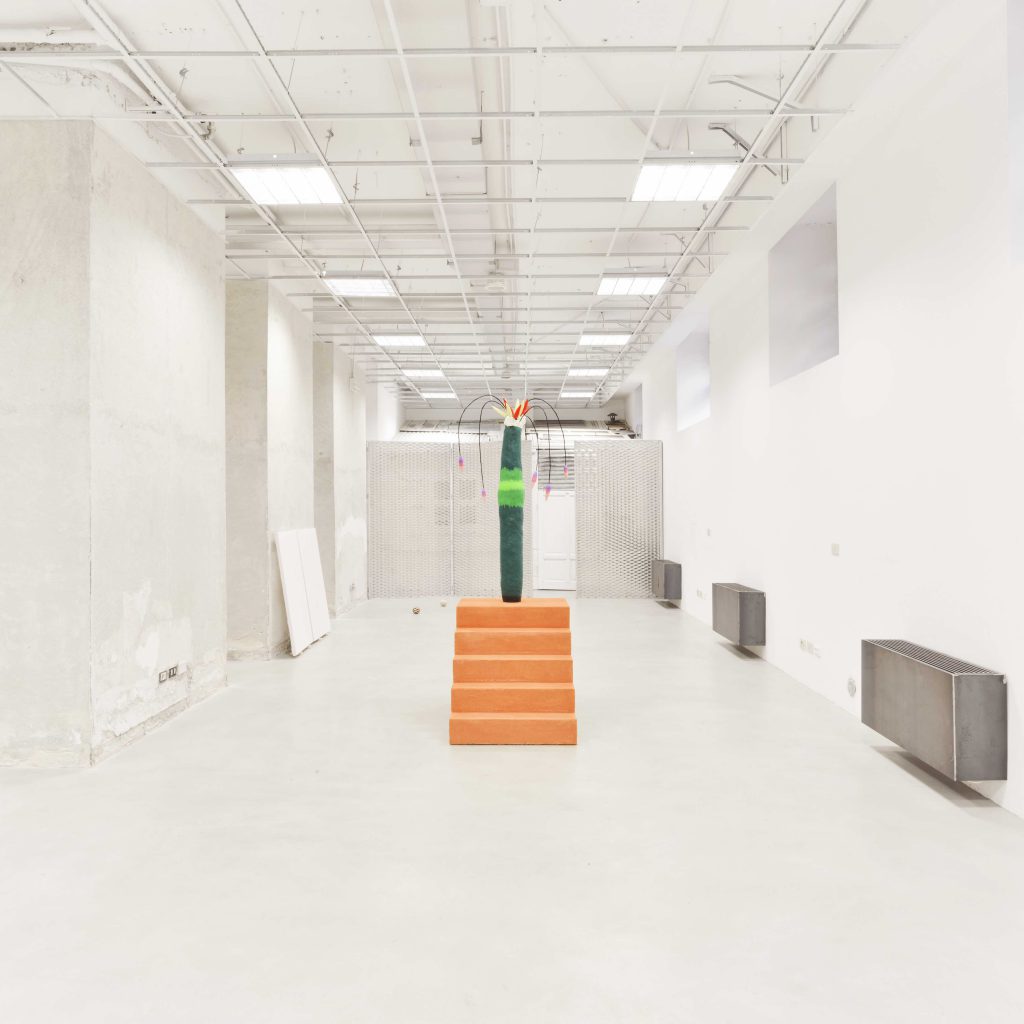
Giovanni Chiamenti, Numen #1, 2019. Installation view State Of, Milan, 2019 Courtesy the artist and State Of Photo Francesco Spallacci
Patrizia Emma Scialpi: I was interested in several things about Cosenza before I arrived at BoCs but, when I walked my first night with you to the old Cosenza, I decided that it would be the perfect opportunity to develop a specific interest about Ultras. This interest comes from my hometown, Taranto (object and subject that eternally returns in my artistic life). At the beginning I was inspired by the connections between Taranto and Cosenza, but later I moved my investigation mainly to a historical group of supporters of Cosenza Football Club. The post-lunch moment with Giovanni (Paolin), Davide, Jacopo, Luca (a friend of Giacomo born in Cosenza), Venturini and Sgamby was fundamental for me; that little moment of relax, coffee and crosswords has naturally become a comparison of stories, references, iconographic and musical research on fans’ movements: The Bologna F.C., The Taranto F.C., Basketball fans, the banners from the Hooligans, the local punk scene, the stadium choirs, the contacts with the ultras, the pub. That day Luca told me about the Pogues!
I agree with Davide La Montagna about the bocs especially in this case and so my “studio” were the Ultras’s places such as bars, the Pogues, the stadium, the slogans on the walls and my work has materialized thanks to the continuous comparison between us during the presentation evenings and in many other moments, in a swimming pool or during the “last” cigarette at 4 a.m.
Pietro Ballero: Before my arrival I was genuinely scared about the production. With such a short time and the need to make a point. I thought I should work hard day and night… I definitely didn’t leave Torino with the idea to go on vacation (and I even carried a printer on trains and buses from Turin to Cosenza ♂). But I learned from this experience that a residency offers artists the opportunity to look at time as a friend: during the residency period we are obliged to stop in a determined place, to put aside all the commitments and finally have the opportunity to do those simple things essential for the growth of an artist, but not always achievable in the middle of everyday daily tasks. Just watching the others at BoCs I realized how an artists practice can be prolific without necessarily feeling anxious to do something.
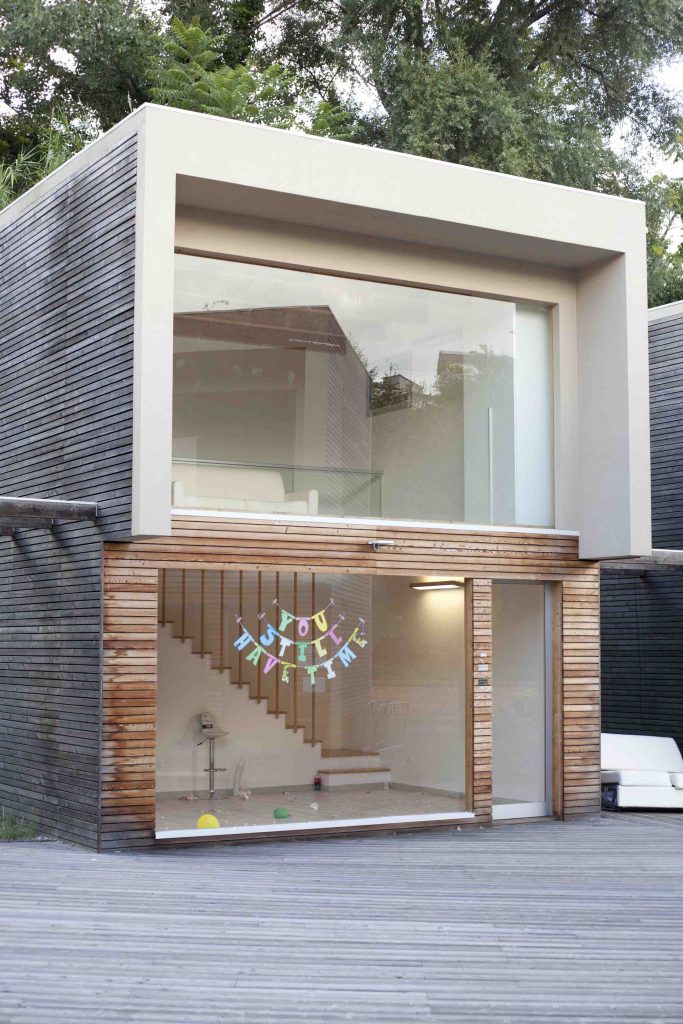
Giovanni Chiamenti: In order to answer Irene’s question I’m gonna talk about my car’s trunk before leaving for Cosenza with Giovannino. I wasn’t sure about what I would have produced during the following days and so I brought with me every sort of material I found in my studio.
I usually do this thing when I go to a residency to have the possibility to find new solutions or to give birth to new projects and that is exactly what happened. At BoCs I started a new research that has grown in the following months during two other residencies I took part in and it led me to the creation of a new series I’ve called NUMEN.
Each residency has its own peculiarities and its own duration so, as an artist, you have to be prepared to get the most out of it. At BoCs every one of us worked hard from the beginning to plan something different from the classic final open studio and that has led us to another level of comprehension of other companions’ research.
Giovanni Chiamenti: In order to answer Irene’s question I’m gonna talk about my car’s trunk before leaving for Cosenza with Giovannino. I wasn’t sure about what I would have produced during the following days and so I brought with me every sort of material I found in my studio.
I usually do this thing when I go to a residency to have the possibility to find new solutions or to give birth to new projects and that is exactly what happened. At BoCs I started a new research that has grown in the following months during two other residencies I took part in and it led me to the creation of a new series I’ve called NUMEN.
Each residency has its own peculiarities and its own duration so, as an artist, you have to be prepared to get the most out of it. At BoCs every one of us worked hard from the beginning to plan something different from the classic final open studio and that has led us to another level of comprehension of other companions’ research.
Irene Angenica : So the new question is… who wants to start talking about Estate, autunno? <3
Pietro Ballero: To meet everyone again a few months later for Estate, Autunno it was a bit like the middle- school “pizzata”, when, after a long time, you see someone out of that environment you used to live everyday. Of course some of us have been meeting other times before that, but to meet again all at once with the idea to continue a path began together was exciting!
Matilde Sambo: It’s a bit strange to think about all of this now, after several months, it really feels like ages. After A JUMI I felt like Milan was a sort of extension of what we made in Cosenza.
With Estate, autunno we made a revisitation of A JUMI. And it is not so easy to find an equilibrium inside a group, and from the inside it is not so easy to have people that can curate every little aspect.
People move, change, go away or stay, but it is always cool when you find people that see the world in a very similar way of yours, meeting people that can see the outside, the aperto, those that are trying to live in those thin and various levels and shades of reality.
And you can understand movement of artists, and so, that came out from chat, readings, talking, drinking…f****** sharing!
Since I moved to Milan I have always had a shared studio, that could be intimate, a place on your own inside which you are always in contact with someone else, even if it is only a coffee or a beer. A place where you can have moments dedicated to the horizontal exchange, sharing doubts, books, music…
In Cosenza I literally covered every corner of the space with my stuff, every space where I was working. If I had to stay inside that bocs for more than 2 days I would be obliged to leave around objects of various nature and type; even my curator Giovanni was amazed of the tons of stuff that I took in those days, together with the big amount of wax I used and he contributed leaving a (really great) piece of iron outside my box one day.
Most of the works that came out from those days were exploration of materials that I’m using in artistic research now.
Let me say one thing: wax and sun are not best friends.
It took me one day to understand that I couldn’t leave any trace of wax on the floor, only the stairs were secure, because when the sun rose the entire bocs was a fire cage.
And yes, very cool, wax reacts to heat, changes its status, and so…but It was everywhere, the red wax was like blood.
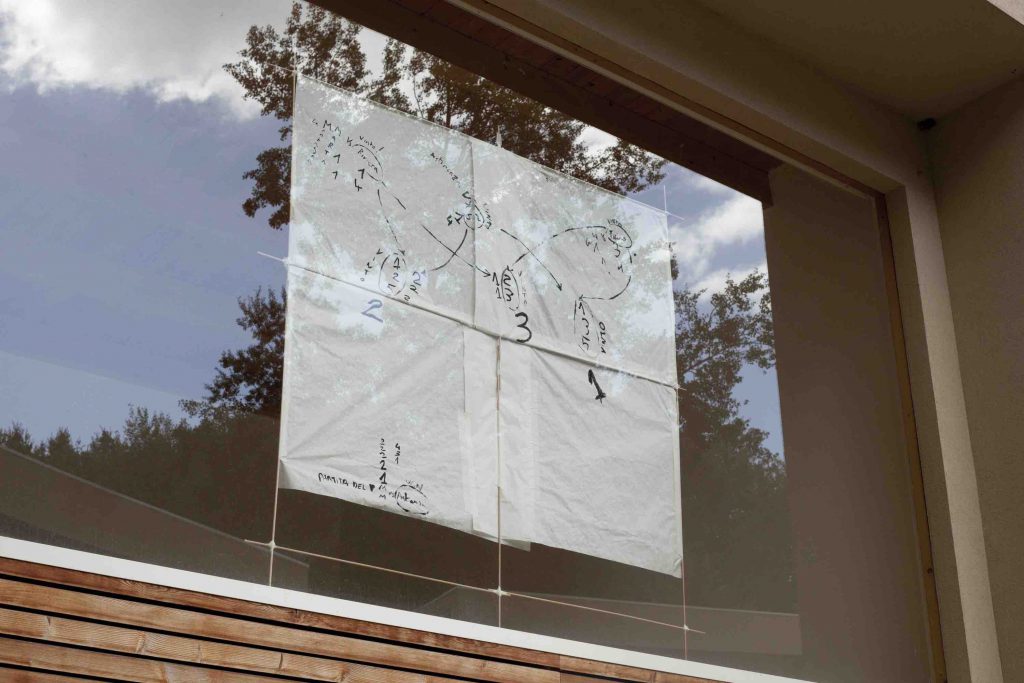
Irene Angenica: But I guess that all of you should have done a “translation” or “evolution” between what you had developed in Cosenza and what you presented in Milan, right?
Davide Sgambaro : My project was physically born in Cosenza where I produced an artist proof and then I’ve brought the first work of the series Parappaparaparapappapara to Milan. Cosenza seemed to me the right place to approach that kind of production focused on a suspended and playful temporality typical of the regenerating boredom of a holiday. When I returned to the studio, in Turin, I had already experimented with the technique for producing finished works, larger in size, but also better structured and controlled. Obviously in Cosenza it would have been quite uncomfortable to produce big works or in any case the dimensions I had thought of, both for a transport factor and also for the budget. It was a natural process, I didn’t even think so much about what to produce during the residency. It must also be said that initially I believed that this series could only be made in the summer because I wanted to use heat and humidity as agents to melt the m&m’s on the sheets. Then after some tests I realized that the visual return was certainly more funny if the m&m’s were wet before throwing them, thus they would also have left the trace of the passage on the white cotton. So I decided to bring the first finished work of this potentially very long series to Milan.
For the Estate, autunno exhibition, on the other hand, we had to deal with a particular space, with some curatorial needs, and therefore that evolution of the work is certainly the result of another kind of approach. As much as the Milan exhibition was the reference to the experience of Cosenza, I noticed two very different situations. There was an excellent curatorial work that allowed us to work with serenity, also there was a lot of tranquility in the air in preparing the exhibition, there was a trust already founded previously thanks to which we managed to work in harmony without worrying too much about restitution of the other artists. And finding ourselves after a season has been very funny!
Giovanni Chiamenti: Clearly the work has evolved during the last months. I’ve experimented with different materials instead of the ones used in Cosenza. For Estate, autunno I created a sort of altar on the top of which there was a sacred plant with multiple and undulant branches.
The installation for me had to represent a feeling, coinciding with the term numinous, that was coined by the religious historian and theologian Rudolf Otto who retained that it was the intimate essence of every religion, or in other words, the holy. The “holy” is manifested as mysterium tremendum e fascinans (fearful and fascinating mystery). The meaning of mysterium, taken in its universal and weakened sense, means merely “secret”, as in being foreign to us, not understood, unexplained, and it constitutes that which we consider a pure analogical notion, purely natural, without actually drawing on reality.
Placing natural elements like plasticine and terracotta powder alongside synthetic materials like polystyrene and polyurethane foam permitted me to get close to the contrasts that Otto used in order to describe this numinous sensation. It is a work about the Holy but it also criticizes the loss of the sacred vision of nature in our geological era.
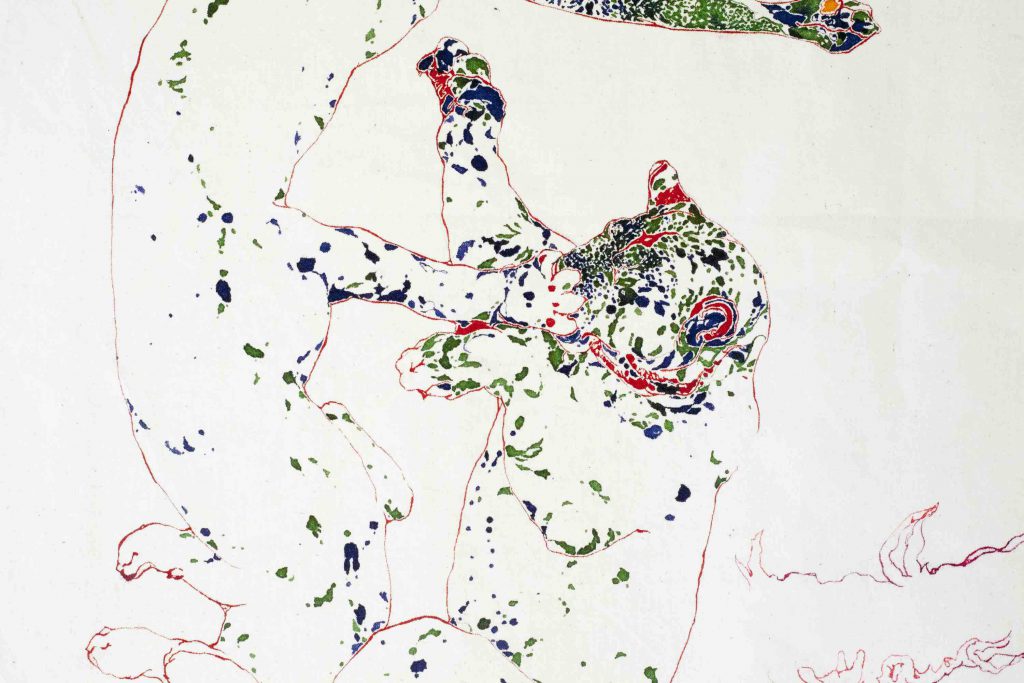
Paolo Bufalini: In my case there wasn’t an evolution, I exhibited the same work in Milan, Auspice, exactly as it was in Cosenza. To answer the previous question, for me the residence was an opportunity to develop a new line of research. In fact, I worked for the first time with writing and sound. In the last year I haven’t had a studio, and the possibility of dedicating 10 days exclusively to the production of a new work allowed me to explore a new ground for me. I found it particularly suitable to my way of working the mix between the isolation of the single bocs and the proximity between us, as well as the alternation between long parts of the day dedicated to the solo work and the pre-established convivial moments (lunch, dinner, portfolio review). Speaking more specifically about my work, it is a dialogue between two ashtrays, who tell each other dreams and comment on them. Somehow the context had a big influence on the writing of the dialogue, where, for example, the dogs hanging around the bocs also appear. In general, the idea of staging a dialogue between two ashtrays refers to those intimate situations that sometimes take place in moments of relaxation, such as a cigarette break.
Paolo Bufalini: In my case there wasn’t an evolution, I exhibited the same work in Milan, Auspice, exactly as it was in Cosenza. To answer the previous question, for me the residence was an opportunity to develop a new line of research. In fact, I worked for the first time with writing and sound. In the last year I haven’t had a studio, and the possibility of dedicating 10 days exclusively to the production of a new work allowed me to explore a new ground for me. I found it particularly suitable to my way of working the mix between the isolation of the single bocs and the proximity between us, as well as the alternation between long parts of the day dedicated to the solo work and the pre-established convivial moments (lunch, dinner, portfolio review). Speaking more specifically about my work, it is a dialogue between two ashtrays, who tell each other dreams and comment on them. Somehow the context had a big influence on the writing of the dialogue, where, for example, the dogs hanging around the bocs also appear. In general, the idea of staging a dialogue between two ashtrays refers to those intimate situations that sometimes take place in moments of relaxation, such as a cigarette break.
k-ways printed with the slogan of a stadium choir but also potential declarations of love to wear. The elements are all there: shapes, slogans, colors, fog, the soundtrack of the choir – borrowed from a famous performance by the Ultras of Naples. I scenically placed colored LEDs and clouds of smoke that enveloped the k-way to read in the fog.
Pietro Ballero: During the reading of L’età dei Muri, a historical essay in which Carlo Greppi analyzes the worrying “new religion of the exclusion” that characterizes our cultural moment, I came across a description of a photo taken in 1941, depicting a balloon seller placed inside the Warsaw Ghetto. It was the biggest Nazi ghetto and at the time when the picture was taken the restrictions imposed on the Jewish people caused more than two thousand deaths a month. The presence of a balloon seller in such a contest appears unbelievable.
The photographer wrote: “In all past years, until this picture was enlarged, if someone had asked me if I had seen balloon sellers in the Ghetto I would have said categorically not. The idea would have struck me as absurd and I could have sworn on oath that I hadn’t; however the picture is proof: in the beginning there were still balloons in the Warsaw Ghetto”.
LOL, the installation that I presented at Estate, autunno, explores the theme of memory through the medial and digital declination. Three digital prints depict a WhatsApp conversation in which some enlargements of the picture in question are shared. In front of them a forest of helium balloons accompanies the viewer to the work.
Balloons and party imagery are the elements that refer to my works at BoCs. In Cosenza I had invited the viewer in an atmosphere linked to that gloomy precise moment of a just ended birthday. Between a deflated balloon and smashed popcorn, some elements trigger a short-circuit, inviting the viewer to think about a consumer and performance society.

Courtesy the artist and BoCs Art
Matilde Sambo: Well, the evolution for my research is something already written and inside the materials that I’m using for a while; wax, soya’s skin, bronze…
The step forward I took after Cosenza was to rethink the way to install (using an aluminium structure that was already in the space) and put in dialogues some of the works that I made during the residency, with other little sculptures that I’m working on, and a video, that I made barely a year ago, speaking and presenting some points of my research on the relationships between humans, the sublime nature and death. In my work I consider every element as fragmented… I always find pieces that need to be cured… with the consciousness that everything is unstable, and all human acts are merely transitory… but only when you can feel emptiness you can try to absorb it and transform it into something that leaves a trace, even if it is infinitesimal… this, I think, is a human necessity for feeling alive.
Davide La Montagna: My work definitely changed, as well as we did. Or, at least, I did. As Matilde said before, I do believe that studio visits or simply talking with colleagues or other artists helps us to get closer, to understand where the works really come from. It’s a sort of psychoanalytic session with a therapist. In fact, I do remember the evening presentations and how things immediately made sense in my head. It makes even more sense now that I know everyone better than before. It might look naive, but maybe the ‘’urgency’’ of making might come from a common place, where our lives intertwine with each other. Artists are egomaniacs in a way, isn’t it?
In order to answer Irene’s question, the two sculptures I showed in Cosenza were pretty different from the one I showed in Milan, basically because of the materials I used to make them. In Cosenza, due to the lack of budget and resources I asked everyone to lend me one of their wool sheets, since every single bocs had one into its wardrobe. The destroyed sofa was kindly transported by Sgambaro & Venturini directly into my bocs. This means that these works are deeply connected with the specific place where the objects are abandoned/found: Not Yet Titled (Come Closer) was, in fact, the mix of a ‘’milanese’’ worn-out furniture and a wool sheet I bought in Turin. Now that I’m writing this answer down I do also believe that the same work will change anyway if shown in another context, because of the context itself. In Cosenza the dialogue between the two works and the place where they were shown recalled a haunted house, or a scene after a move. In Milan, even if the attitude was the exact same one as Cosenza, it looked like something else, because of the empty space, or the ‘’white cube’’ let’s say.

Jacopo Belloni: The work presented in Milan was a natural continuation of the BoCs Art project, although formally it may seem very different. The idea of the vulnerability of the body and the relationship of objects related to its care remained alive in my mind. So I tried to increase the dichotomy between an innate fragility of the human being and the simulation of an aggressive attitude. The project realized for Estate, autunno was a series of raku ceramics that reproduce the internal prostheses that replace the joints of upper and lower limbs. In the medical field these prostheses have an offensive form, similar to blunt weapons that hide in the body to cure and preserve it. The series therefore reproduces ambiguous objects, apparently sharp and aggressive, but with a therapeutic function. Also the technique used is equivocal; raku is a firing for oxygen reduction that blackens the surface of the ceramic giving it a carbonized effect. The use of the “terra sigillata”, a very oily liquid ceramic that I applied to the pieces before firing, has made it possible to create metallic effects similar to burnishing. Apparently the material seems aggressive and strong too, but it turns out to be extremely fragile. The display instead wants to resume a sanitary aesthetics similar to surgical devices, which in this case turns into a sort of reliquary to accommodate fragments that replace the body. This idea of body replacement is a point that incredibly fascinates me. Ideally all the work is based on terracotta ex-votos that in ancient times, throughout the Mediterranean basin and beyond, were offered by the worshippers to the gods to ask for the cure of a sick part. The reproduction of the body is extremely linked to the fear of its loss.
Giovanni Giacomo Paolin: Chat time has expired! We really hope this conversation could give some food for thought to anyone that has the patience to read it, we talked about a lot of topics and we hope to give our contribution for a new way to approach artistic projects. I think the most appropriate way to sum up our point of view can be referring to our project Tonico Caldo and its sense of conviviality and active idleness: a residency, an exhibition, as well as a 30 euro plastic pool can represent a collective work carried out by 15 fantastic people all together.




